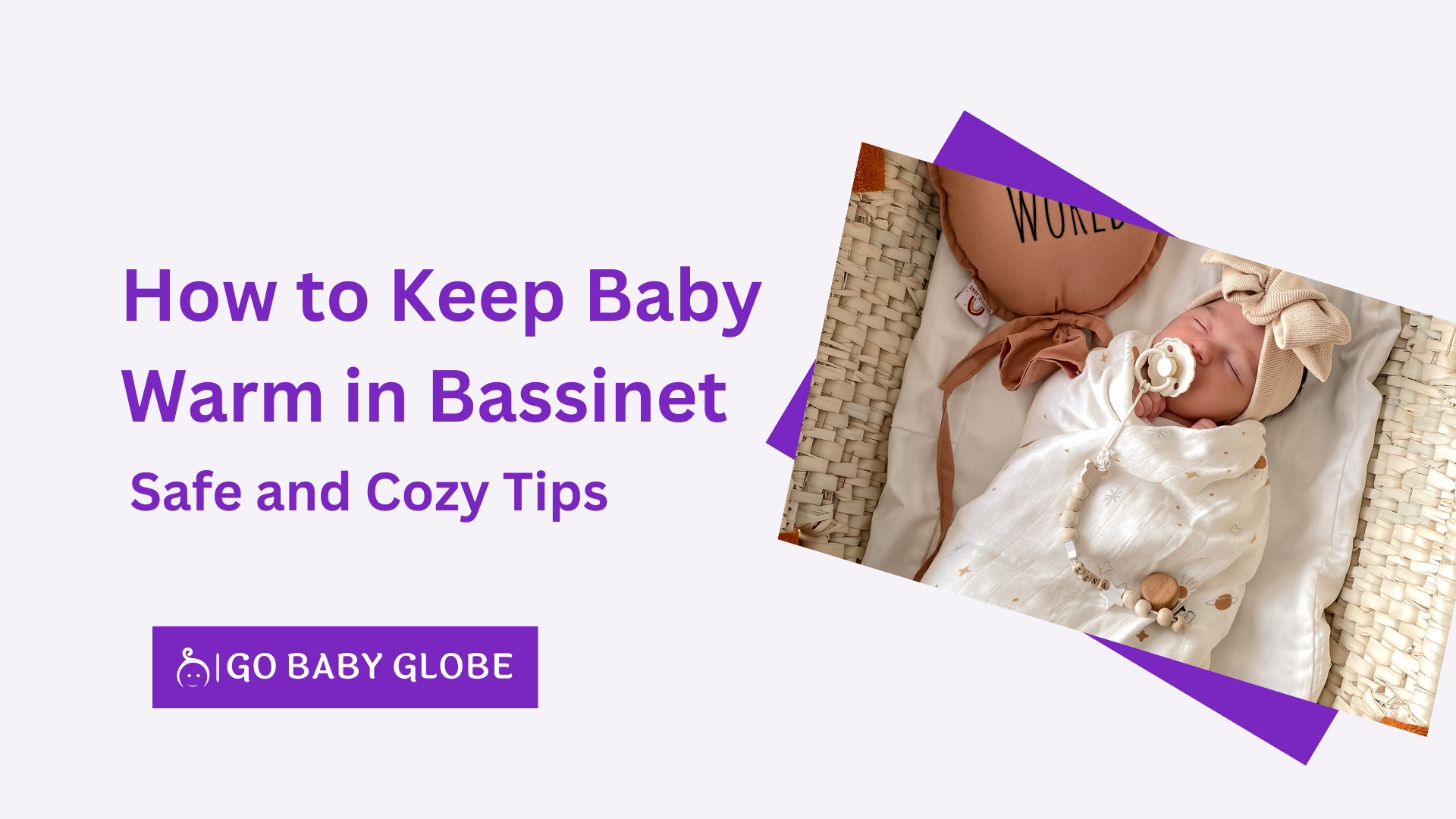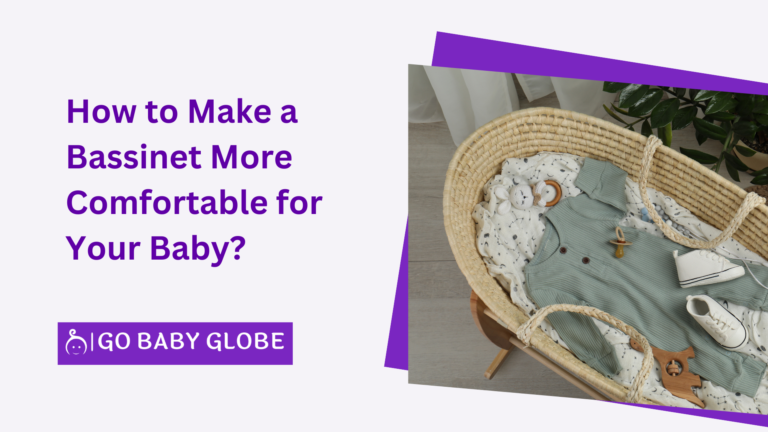How to Keep Baby Warm in Bassinet: Safe and Cozy Tips
In this guide your will learn How to Keep Baby Warm in Bassinet? basically we will cover some effective tips which will help you keep your baby warm and comfortable in bassinet.
here is a list of what we are going to cover.
Why is it important to keep your baby warm in the bassinet?
Keeping your baby warm is crucial for their safety and comfort. As newborns hardly regulate their body temperature. Babies lose heat rapidly as compared to adults. Because newborns have larger surface area relative to their volume. For example, a newborn has a 3 times larger surface area as compared to an adult, relative to their weight, This means a newborn loses heat 3 times faster than adults.
That being said, you need to make sure that your baby neither gets too cool, nor too warm, as both of them could lead to serious health issues.
For example, if your baby gets too cool, it could lead to Hypothermia, this is a condition, in which body temperature drops below normal ( 95 degrees Fahrenheit), and as a result, it can potentially be life-threatening.
In the same way, If your baby gets too warm, it could lead to Hyperthermia, which is a condition in which normal body temperature rises above 100.4 degrees Fahrenheit, this is also life-threatening and can cause major health issues.
So, in a nutshell, keeping your baby warm in the bassinet can truly reduce the risks of all these health issues. Not only this but keeping your baby warm also allows your baby to sleep well and grow better.
Importance of maintaining proper body temperature
Maintaining proper body temperature is crucial for all people, but for newborns, it becomes even more important, as babies have a higher surface area to volume ratio as compared to adults, which means they lose heat faster than adults, and as a result, they get cool faster.
On the other hand, overheating is also life-threatening, babies get overheated faster than adults, because they are still developing and their immune system is weak at this stage, that said, overheating is a real life-threatening, because it increases the chances of SIDS
Understanding the optimal temperature for the bassinet
So, what should be the optimal temperature for a bassinet? Well, the ideal temperature for a bassinet is between 68 and 72 degrees Fahrenheit. The temperature will help you to keep your baby warm, and comfortable and will reduce the risk of getting overheated.
Here is a list of tips which you can follow to maintain the optimal temperature of the bassinet.
- Make sure that the bedding is fitted to the bassinet. Loose bedding can be a suffocation hazard.
- Choose bedding materials that are breathable and comfortable.
- Avoid using synthetic bedding materials, as these can trap heat and increase the risk of overheating.
- Layer bedding so that you can adjust it as needed. For example, you can remove a layer of bedding if your baby seems too warm, or add a layer if they seem too cold.
- Monitor your baby’s temperature regularly. A good rule of thumb is to dress your baby in one more layer of clothing than you are wearing.
Choosing the right bedding for the bassinet
When it comes to selecting bedding for your baby’s bassinet, it’s important to consider the impact it can have on regulating their body temperature. The right bedding not only provides comfort but also plays a vital role in keeping your little one warm and cozy.
Types of bedding materials to consider
The following are some bedding materials to consider for your baby’s bassinet:
Cotton
Cotton is a natural fiber that is known for its breathability and softness. It is a good choice for bedding for babies of all ages, as it can help to keep them cool in the summer and warm in the winter. Cotton is also relatively hypoallergenic, making it a good choice for babies with sensitive skin.
Flannel
Flannel is a soft, warm fabric that is made of cotton or a blend of cotton and synthetic fibers. It is a good choice for bedding for babies in the winter, as it can help to keep them warm and cozy. Flannel is also relatively absorbent, so it can help to keep babies dry if they spit up or leak.
Wool
Wool is a natural fiber that is known for its ability to regulate temperature. It can keep babies warm in the winter and cool in the summer. Wool is also naturally flame-resistant and hypoallergenic. However, wool can be expensive and difficult to care for.
Synthetic materials
Synthetic materials, such as polyester and fleece, are often less expensive and easier to care for than natural fibers. However, they are also less breathable and can trap heat, which can increase the risk of overheating. Synthetic materials are not recommended for bedding for babies under the age of one.
When choosing bedding for your baby’s bassinet, it is important to consider the following factors:
- Climate: If you live in a warm climate, you will want to choose bedding materials that are lightweight and breathable. If you live in a cold climate, you will want to choose bedding materials that are warm and insulating.
- Season: It is important to adjust your baby’s bedding according to the season. In the summer, you will want to use lighter bedding materials. In the winter, you will want to use heavier bedding materials.
- Your baby’s body temperature: It is important to monitor your baby’s body temperature to make sure that they are not too hot or too cold. If your baby is too hot, you can remove a layer of bedding. If your baby is too cold, you can add a layer of bedding.
If you are unsure which bedding materials are right for your baby, be sure to talk to your pediatrician.
Tips for layering bedding in the bassinet
Properly layering bedding in the bassinet is crucial to ensure your baby stays comfortably warm. Start with a fitted sheet as the base layer, ensuring it fits snugly on the mattress. Next, add a lightweight blanket or swaddle for added warmth. Remember to tuck it securely around your baby, ensuring there are no loose ends that could pose a safety risk.
If the room temperature is cooler, you can add another layer such as a thicker blanket or a sleep sack. Sleep sacks are a great option as they provide warmth without the need for loose blankets, reducing the risk of suffocation. Make sure the sleep sack is the right size for your baby, allowing for proper movement and circulation.
It’s vital to regularly check your baby’s temperature to ensure they are not too hot or too cold. Feel the back of their neck or their tummy to get an accurate gauge of their body temperature. If they feel sweaty or clammy, remove a layer of bedding. On the other hand, if they feel cold to the touch, add an extra layer to keep them cozy.
By choosing the right bedding materials and layering them correctly, you can create a comfortable and safe sleeping environment for your baby. Remember, their comfort and safety should always be the top priority.
Dressing your baby for warmth in the bassinet
When it comes to dressing your baby for warmth in the bassinet, choosing the right fabrics is crucial. The fabric of your baby’s clothing plays a significant role in keeping them comfortable and snug. Opt for soft and breathable materials such as cotton, bamboo, or organic fabrics. These fabrics are gentle on your baby’s delicate skin and allow air circulation, preventing overheating. Avoid synthetic materials like polyester or nylon, as they can trap heat and cause discomfort.
Choosing the right fabrics for baby clothing
Cotton is one of the most popular fabric choices for baby clothing. It is soft, hypoallergenic, and allows your baby’s skin to breathe, making it ideal for dressing your little one in the bassinet. Another excellent option is bamboo fabric, which is naturally antibacterial and moisture-wicking. It helps regulate your baby’s body temperature, keeping them warm in winter and cool in summer. Organic fabrics, made from natural fibers, are also a great choice as they are free from harmful chemicals and pesticides.
Tips for layering clothing in the bassinet
Layering your baby’s clothing is a practical way to keep them warm without the risk of overheating. Start with a base layer made of lightweight, breathable fabric like a cotton onesie or a bodysuit. This layer will help trap warmth close to your baby’s body while allowing moisture to evaporate. For added warmth, add a long-sleeved shirt or a sweater made of soft, natural fibers like merino wool. Remember not to overdress your baby, as overheating can increase the risk of SIDS (Sudden Infant Death Syndrome).
To further protect your baby from the cold, consider using a sleep sack or a swaddle blanket. These snug and cozy alternatives to blankets provide warmth without the risk of suffocation. Ensure that the sleep sack or swaddle blanket fits your baby properly and does not cover their face.
In conclusion, dressing your baby for warmth in the bassinet requires careful consideration of the fabrics and layering techniques. Choose soft and breathable materials like cotton or bamboo, and avoid synthetic fabrics that can trap heat. Layer your baby’s clothing appropriately, starting with a base layer and adding additional layers for warmth. Remember to use sleep sacks or swaddle blankets to provide extra coziness without compromising their safety. By following these tips, you can ensure that your baby stays comfortable and warm in the bassinet.
Utilizing additional sources of warmth in the bassinet
When it comes to keeping your little one cozy and comfortable in their bassinet, there are a few extra measures you can take to ensure they stay warm throughout the night. Along with safe sleeping practices such as laying them on their back and avoiding loose bedding, utilizing additional sources of warmth can provide that extra level of comfort.
Safe use of blankets and swaddles
Blankets and swaddles can be a great way to keep your baby snug and warm, but it’s important to use them safely. Opt for lightweight blankets that are breathable and avoid using ones with large or loose weaves, as they can pose a suffocation risk. Remember to keep blankets away from your baby’s face and ensure they are securely tucked in around the bassinet mattress. If you prefer swaddling your little one, make sure to use a swaddle blanket or sleep sack specifically designed for that purpose, as they provide a secure and cozy fit without the risk of unraveling.
Using portable heaters or warmers
In colder months or drafty rooms, a portable heater or warmer can be a lifesaver to maintain a comfortable temperature in the bassinet. However, it’s crucial to use them safely. Choose a heater with built-in safety features such as tip-over protection and automatic shut-off, and keep it at a safe distance from the bassinet to prevent any potential accidents. Additionally, avoid placing the heater directly next to your baby or covering the bassinet with any blankets or materials that could pose a fire hazard.
By incorporating these additional sources of warmth in the bassinet, such as safe use of blankets and swaddles and the use of portable heaters or warmers, you can create a cozy and secure environment for your little one to sleep soundly. Remember, always prioritize safety and follow the guidelines to ensure a peaceful and warm slumber for your precious bundle of joy.
Monitoring your baby’s warmth in the bassinet
Ensuring that your baby is warm and comfortable while sleeping in the bassinet is essential for their well-being. To help you maintain the perfect temperature, there are a few strategies you can utilize.
Using a room thermometer
One effective method is to use a room thermometer in the nursery. This handy device will provide you with accurate temperature readings, allowing you to adjust the room accordingly. Ideally, the temperature should be between 68-72 degrees Fahrenheit (20-22 degrees Celsius) for optimal comfort. By keeping an eye on the thermometer, you can make sure that your baby’s sleeping environment is neither too hot nor too cold.
Observing your baby’s cues and behaviors
In addition to using a room thermometer, it’s crucial to pay attention to your baby’s cues and behaviors. Babies are unable to regulate their body temperature as effectively as adults, so it’s important to watch out for signs of discomfort or overheating. If your baby is sweating, flushed, or seems restless, it may be an indication that they are too warm. On the other hand, if they’re shivering or have cold extremities, they may be too cold. By observing your baby closely, you can make necessary adjustments to their clothing or bedding to ensure they stay cozy and snug in the bassinet.
By combining the use of a room thermometer with your attentiveness to your baby’s cues, you can create a warm and safe environment in the bassinet. Your baby will sleep peacefully, knowing that you are taking all the necessary steps to keep them comfortable throughout the night.
Also read.








One Comment
Comments are closed.